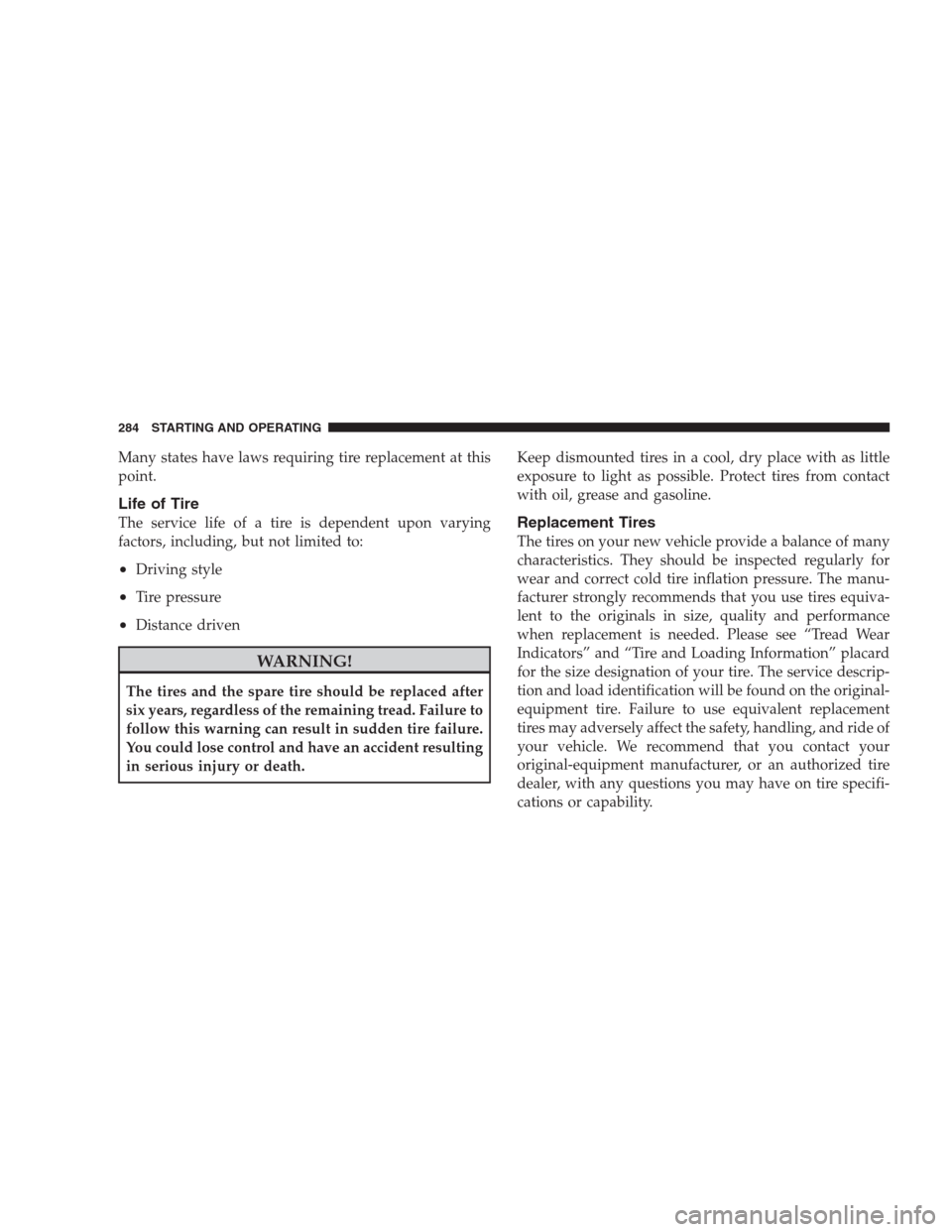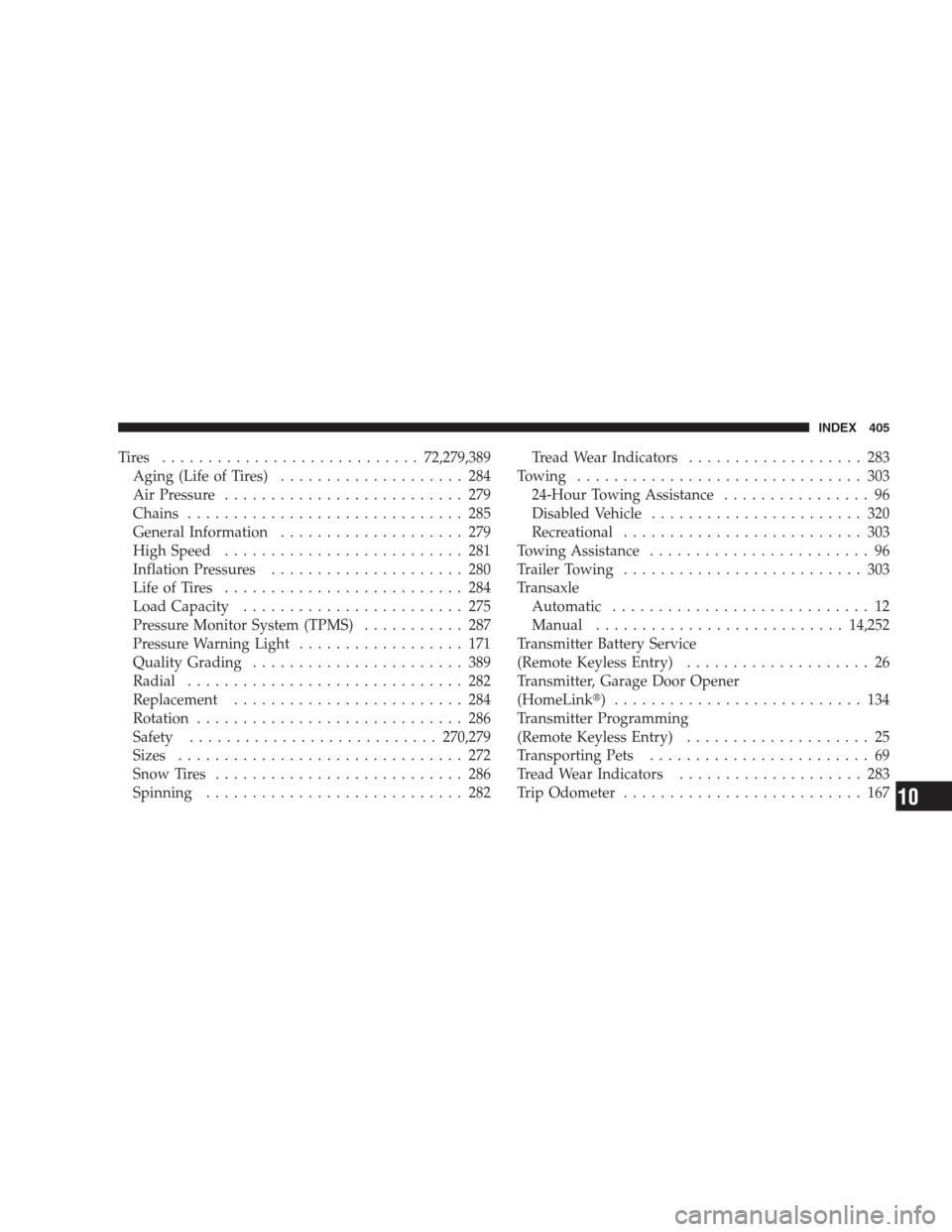Page 286 of 411

Many states have laws requiring tire replacement at this
point.
Life of Tire
The service life of a tire is dependent upon varying
factors, including, but not limited to:
•Driving style
•Tire pressure
•Distance driven
WARNING!
The tires and the spare tire should be replaced after
six years, regardless of the remaining tread. Failure to
follow this warning can result in sudden tire failure.
You could lose control and have an accident resulting
in serious injury or death.Keep dismounted tires in a cool, dry place with as little
exposure to light as possible. Protect tires from contact
with oil, grease and gasoline.
Replacement Tires
The tires on your new vehicle provide a balance of many
characteristics. They should be inspected regularly for
wear and correct cold tire inflation pressure. The manu-
facturer strongly recommends that you use tires equiva-
lent to the originals in size, quality and performance
when replacement is needed. Please see “Tread Wear
Indicators” and “Tire and Loading Information” placard
for the size designation of your tire. The service descrip-
tion and load identification will be found on the original-
equipment tire. Failure to use equivalent replacement
tires may adversely affect the safety, handling, and ride of
your vehicle. We recommend that you contact your
original-equipment manufacturer, or an authorized tire
dealer, with any questions you may have on tire specifi-
cations or capability.
284 STARTING AND OPERATING
Page 289 of 411

Follow the recommended tire rotation frequency for your
type of driving found in the “Maintenance Schedules”
section of this manual. More frequent rotation is permis-
sible if desired. The reasons for any rapid or unusual
wear should be corrected prior to rotation being per-
formed.
TIRE PRESSURE MONITORING SYSTEM (TPMS)
•
The Tire Pressure Monitor System (TPMS) will warn
the driver of a low tire pressure based on the vehicle
recommended cold placard pressure.
•The tire pressure will vary with temperature by about
1 psi (6.9 kPa) for every 12°F (6.5°C). This means that
when the outside temperature decreases, the tire pres-
sure will decrease. Tire pressure should always be set
based on “cold inflation tire pressure”. This is defined
as the tire pressure after the vehicle has not been
driven for at least three hours, or driven less than
1 mile (1 km) after a three hour period. The cold tire
inflation pressure must not exceed the maximum
inflation pressure molded into the tire sidewall. Refer
to “Tires – General Information” in this section for
information on how to properly inflate the vehicle’s
tires. The tire pressure will also increase as the vehicle
is driven - this is normal and there should be no
adjustment for this increased pressure.
STARTING AND OPERATING 287
5
Page 291 of 411

CAUTION!
•The TPMS has been optimized for the original
equipment tires and wheels. TPMS pressures and
warnings have been established for the tire size
equipped on your vehicle. Undesirable system
operation or sensor damage may result when us-
ing replacement equipment that is not of the same
size, type, and/or style. Aftermarket wheels can
cause sensor damage. Do not use aftermarket tire
sealants or balance beads if your vehicle is
equipped with a TPMS, as damage to the sensors
may result.
•After inspecting or adjusting the tire pressure,
always reinstall the valve stem cap. This will
prevent moisture and dirt from entering the valve
stem, which could damage the Tire Pressure Moni-
toring Sensor.NOTE:
•The TPMS is not intended to replace normal tire care
and maintenance or to provide warning of a tire failure
or condition.
•The TPMS should not be used as a tire pressure gauge
while adjusting your tire pressure.
•Driving on a significantly under-inflated tire causes
the tire to overheat and can lead to tire failure.
Under-inflation also reduces fuel efficiency and tire
tread life, and may affect the vehicle’s handling and
stopping ability.
•The TPMS is not a substitute for proper tire mainte-
nance, and it is the driver ’s responsibility to maintain
correct tire pressure using an accurate tire gauge, even
if under-inflation has not reached the level to trigger
illumination of the Tire Pressure Monitoring Telltale
light.
STARTING AND OPERATING 289
5
Page 292 of 411

•Seasonal temperature changes will affect tire pressure,
and the TPMS will monitor the actual tire pressure in
the tire.
Base System
This is the TPMS warning indicator located in the
instrument cluster.
The TPMS uses wireless technology with wheel rim
mounted electronic sensors to monitor tire pressure lev-
els. Sensors, mounted to each wheel as part of the valve
stem, transmit tire pressure readings to the Receiver
Module.
NOTE:It is particularly important for you to check the
tire pressure in all of the tires on your vehicle regularly
and to maintain the proper pressure.
The TPMS consists of the following components:
•Receiver Module
•Four Tire Pressure Monitoring Sensors
•Tire Pressure Monitoring Telltale Light
Tire Pressure Monitoring Low Pressure Warnings
The Tire Pressure Monitoring Telltale Light will illumi-
nate in the instrument cluster, and an audible chime will
be activated when one or more of the four active road tire
pressures are low. Should this occur, you should stop as
soon as possible, check the inflation pressure of each tire
on your vehicle, and inflate each tire to the vehicle’s
recommended cold placard pressure value. The system
will automatically update and the Tire Pressure Monitor-
ing Light will extinguish once the updated tire pressures
have been received. The vehicle may need to be driven
for up to 20 minutes above 15 mph (25 km/h) to receive
this information.
290 STARTING AND OPERATING
Page 316 of 411

(D) After Injecting TIREFIT Sealant:
1. Allow the air pump to inflate the tire to the pressure
indicated on the tire pressure label on the driver-side
latch pillar. Check the pressure in the tire by looking at
the Pressure Gauge (2).
•If the tire inflates to at least 26 psi (1.8 bar) within
15 minutes, proceed to Step 2 of this procedure.
•If tire fails to inflate to 26 psi (1.8 bar) within
15 minutes, perform the procedure steps described
under “(G) Distributing TIREFIT Sealant to Better
Enable Tire Inflation.”
2. Press the Air Pump Power Button (3) to
turn OFF the TIREFIT kit.3. Remove the Speed Limit sticker from the top of the
Sealant Bottle (1) and place the sticker on the steering
wheel.
4. Disconnect the Clear Sealant Hose (7) from the valve
stem, reinstall the Yellow Cap on the fitting at the end of
the hose, and place the TIREFIT kit in the vehicle.
CAUTION!
Failure to reinstall the Yellow Cap on the fitting at
the end of the Clear Sealant Hose (7) can result in
sealant contacting your skin, clothing, and the vehi-
cle’s interior. It can also result in sealant contacting
internal TIREFIT kit components causing permanent
damage to the kit.
(E) Securing TIREFIT Sealant in the Tire
Drive the vehicle for approximately 5 miles (8 km) to
ensure distribution of the TIREFIT Sealant within the tire.
314 WHAT TO DO IN EMERGENCIES
Page 407 of 411

Tires ............................72,279,389
Aging (Life of Tires).................... 284
Air Pressure.......................... 279
Chains.............................. 285
General Information.................... 279
High Speed.......................... 281
Inflation Pressures..................... 280
Life of Tires.......................... 284
Load Capacity........................ 275
Pressure Monitor System (TPMS)........... 287
Pressure Warning Light.................. 171
Quality Grading....................... 389
Radial.............................. 282
Replacement......................... 284
Rotation............................. 286
Safety...........................270,279
Sizes............................... 272
Snow Tires........................... 286
Spinning............................ 282Tread Wear Indicators................... 283
Towing............................... 303
24-Hour Towing Assistance................ 96
Disabled Vehicle....................... 320
Recreational.......................... 303
Towing Assistance........................ 96
Trailer Towing.......................... 303
Transaxle
Automatic............................ 12
Manual...........................14,252
Transmitter Battery Service
(Remote Keyless Entry).................... 26
Transmitter, Garage Door Opener
(HomeLink�) ........................... 134
Transmitter Programming
(Remote Keyless Entry).................... 25
Transporting Pets........................ 69
Tread Wear Indicators.................... 283
Trip Odometer.......................... 167
INDEX 405
10